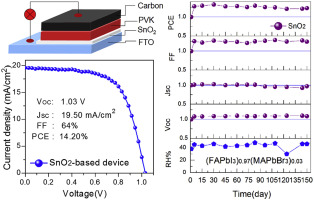Organic Electronics ( IF 2.7 ) Pub Date : 2017-12-05 , DOI: 10.1016/j.orgel.2017.12.002 Siyuan Lin , Bingchu Yang , Xincan Qiu , Jiaqi Yan , Jiao Shi , Yongbo Yuan , Wenjun Tan , Xiaoliang Liu , Han Huang , Yongli Gao , Conghua Zhou

|
Efficient and stable planar hole-transport-layer-free perovskite solar cells were fabricated using low temperature processed tin dioxide (SnO2, 180 °C) as electron-transport-material and carbon film (100 °C) as top electrode. Open circuit voltage of 1.03 ± 0.02 (highest at 1.07) V was obtained, which was 100 mV higher than that of reference devices using conventional high-temperature-processed mesoporous TiO2 as electron-transport-material, or 0.91 ± 0.03 (highest at 0.96) V. The increased open circuit voltage along with slightly-upgraded fill factor then helped to upgrade power conversion efficiency to 13.21 ± 0.7% (highest at 14.5%) under simulated illumination of AM 1.5 G, 100 mW/cm2, compared to 10.13 ± 1.34% (highest at 10.46%) of the reference devices. The improvement is ascribed to the upgraded built-in potential. Mott–Schottky study showed that, using low-temperature-processed SnO2 as electron-transport-material, higher built-in-potential (0.94 V) could be obtained, compared with 0.89 V of TiO2 based device, which then retarded charge recombination and thus increased both of the open circuit voltage and fill factor. Meanwhile, stability was test. Without any encapsulation, storage stability up to 150 days (3600 h, the test is still on-going) has been obtained for devices kept in dark (relative humidity ∼45%), which is contributed by the low photo-activity SnO2, and the adoption of formamidinium cations, bromide anions co-doped perovskite film.
中文翻译:

使用低温处理的SnO 2作为电子传输材料的高效,稳定的无平面平面空穴传输材料的钙钛矿太阳能电池
利用低温处理的二氧化锡高效且稳定的平面空穴传输层-自由钙钛矿太阳能电池制造(SNO 2,180℃)用作电子传输材料和碳薄膜(100℃)作为上电极。获得的开路电压为1.03±0.02(最高为1.07)V,比使用常规高温处理的中孔TiO 2作为电子传输材料的参考器件的开路电压高100 mV ,或者为0.91±0.03(最高为1.03)。 0.96)V。增加的开路电压以及略微提高的填充系数随后帮助在模拟AM 1.5 G,100 mW / cm 2的照明条件下将功率转换效率提升至13.21±0.7%(最高为14.5%)。,而参考设备为10.13±1.34%(最高为10.46%)。改进归因于升级后的内置潜力。Mott–Schottky研究表明,与TiO 2基器件的0.89 V相比,使用低温处理的SnO 2作为电子传输材料可以获得更高的内建电位(0.94 V)。重组,从而增加了开路电压和填充因数。同时,测试稳定性。没有任何封装,对于黑暗中(相对湿度为〜45%)的设备,其光活性SnO 2低有助于获得长达150天(3600小时,测试仍在进行中)的存储稳定性。,并采用甲ami阳离子,溴阴离子共掺杂钙钛矿薄膜。











































 京公网安备 11010802027423号
京公网安备 11010802027423号